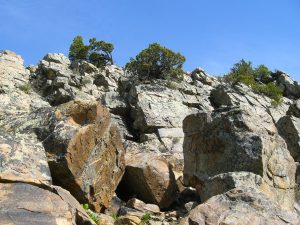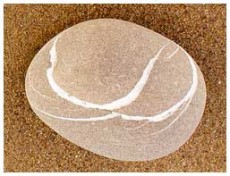
I tried to explain Big Rock to my four grandkids, how what seemed towering now looks tiny. But the oldest, twin nine-year-olds, don’t know metaphor or how views change with time.
My younger siblings, neighborhood pals and I loved Big Rock, dumped our bikes at the base of this formation along the side of Big Rock Road and played there for hours.
Sometimes the big kids, as we older ones called ourselves, helped the little kids climb, if we felt kind. Sometimes we would have already claimed our ground and waged territorial war against the late comers. Big Rock loomed huge to us, like a cliff. At age twelve, I bragged to Mom and Dad when I learned to scale its rockface. I recall telling the younger ones, “You’ll fall. You’ll get hurt. You won’t make it.”
We imagined it as our place. Magic. Special. Full of challenges.
The boys waved their fake guns at Big Rock and ran over the rugged terrain in battles of their own making. Golfers, from the closely manicured green nearby, or the overgrown rough, or the smooth fairway on the course next to Big Rock, yelled to us, “Quiet down.”
We paid little mind to the men and women lining up putts on pristine man-made chemicalized grass. We busied ourselves, even ripping pants and t-shirts, leaping around the slippery slopes of granite in the natural woods where Big Rock rose. “The plains” on the flat top of Big Rock opened in plain sight to properly-dressed people wanting a good round on the links. We figured they knew us. We hoped they wouldn’t tell our parents how raucously we ruckused.
After dark we’d take flashlights to Big Rock and hunt for lost golf balls. We’d give them to Dad or use them to build forts on Big Rock, with branches, leaves and dropped pine needles. We’d sweep Big Rock of nature’s debris, make out of it what we called walking sticks, uncover Big Rock’s coarse texture and use anything we could find to make boundaries, “We hang out here. You stay there. Don’t cross this line.”
Grown up now, I took pictures at Big Rock this morning for a peek into those growing up years. Big Rock, not that big and easily mountable, stands not much taller than me. Today no bikes piled up at its base, no kids played war games or divided up stake-out spots. Lots of moss covered it, lots of sticks and stones strewn about. Memories flooded me, like walking down Big Rock Road holding hands with my first love. He broke up with me three times near Big Rock. Those break-ups felt like boulders, insurmountable, as if I would fall from them, get hurt, as if I’d never be loved or love again. He grew to love someone else. So did I, which makes Big Rock look now more like a teacher of life, a stepping stone to adulthood, a past pebble on the path to present personhood, that path also magic, special, and full of challenges. Any teenager, climbing Big Rock, could hop to the top. But maneuvering around boulders as we journey to maturity tests us. We must climb cliffs. And years later debris can remain in our hearts. And the grit, grime and grains of sand, weathered and worn over the years, can still teach us.
Little kids, the younger ones, might not understand yet how the concrete implies the symbolic. I’ll show my grandchildren the photos and spare them the metaphor.



So true…I have often had those experiences of revisiting a childhood haunt and remembering it being so much more than it really is. But as we age, those early life challenges layer one on top of another, providing the steps to the big thing. You are such a good writer and always provide me with something to think about. Thanks so much.